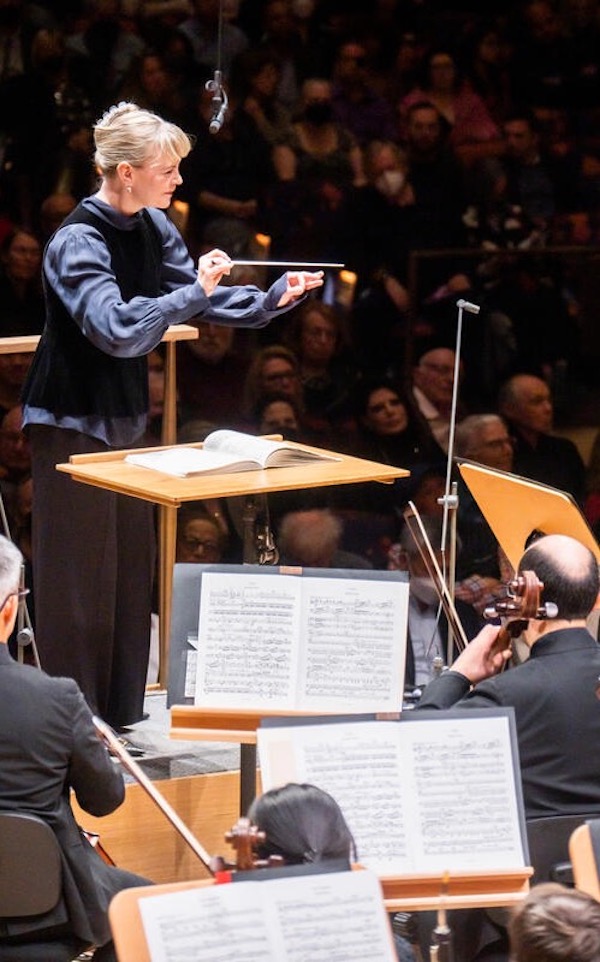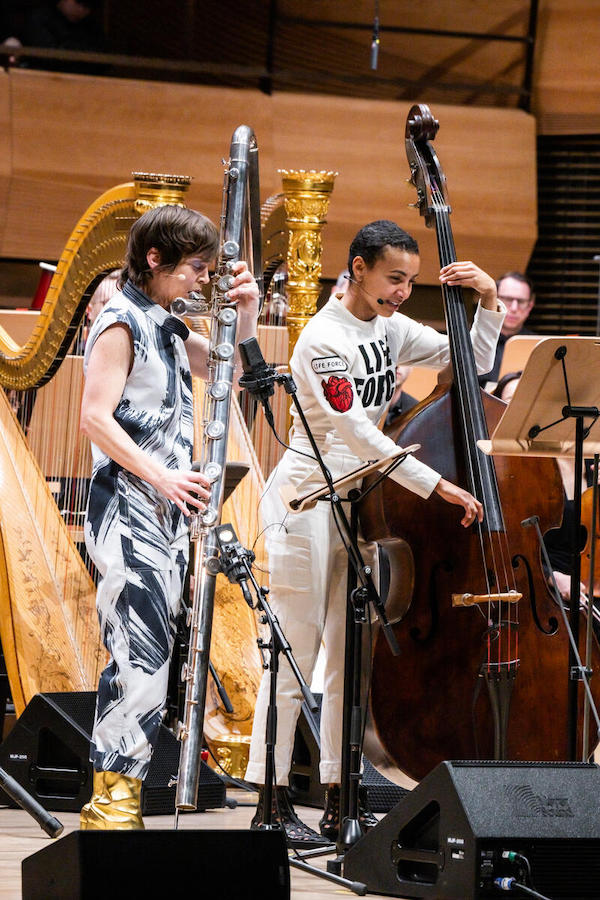Mälkki ignites Philharmonic with fresh Ives, Stravinsky and new double concerto

With rarefied Ives, a bold new concerto, and a scintillating Petrushka, Susanna Mälkki and the New York Philharmonic put the reconfigured David Geffen Hall through its acoustical paces Wednesday night.
The innovative musicians Claire Chase and esperanza spalding crashed the symphonic party, making their Philharmonic debuts as the soloists in the New York premiere of Felipe Lara’s Double Concerto for flutes and double bass.
But to begin, Geffen’s resonant space was marked off by players stationed around the room for Charles Ives’s The Unanswered Question, a pioneering work of “spatial music.” Impassive, sempre pianissimo strings onstage made the “sound of silence” while, high in the second tier, a lone trumpet repeatedly posed its inscrutable question and a quartet of flutes sporadically searched for answers.
Conductor Mälkki kept Ives’s six-minute tableau at the brink of audibility, as weightless as a thought.
Coincidentally, a quartet of flutes was Claire Chase’s medium in the concerto, as she switched among the familiar flute in C, an alto flute in G, a glissando headjoint that produced swooping slide-whistle tones, and the contrabass flute in C, a gleaming, angular piece of pipe sculpture that stood taller than Chase herself.
Plucking her string bass and vocalizing in the Brazilian composer’s native Portuguese, spalding combined with Chase’s novel instruments and playing techniques to make what the flutist called, in a program note, “a many-tentacled creature.” Discreet amplification balanced the soloists’ subtle sounds with the large orchestra.

Mälkki—who had godmothered this piece from a new friendship of two exceptional musicians to a concerto commission for them from the Helsinki Philharmonic and the Los Angeles Philharmonic—expertly oversaw the boom-slap of percussion and the short, wrenching string phrases that punctuated the solos in the early going.
The half-hour, one-movement piece spun through fast solos driven by xylophone and urgent brass to a soft interlude for pinging harps over pillowy strings. Just by the nature of her instruments, Chase tended to dominate the sonic picture with an array of buzzes, hisses, shrieks, overblown sforzandos and percussive key slaps. (Overblowing the big bass flute produced a chuffing sound like a locomotive gathering steam.) But when the two players reached their solo cadenza late in the piece, they blew and plucked into a (presumably improvised) frenzy.
After Mälkki drew out one last forte statement to cap the piece, the conductor, soloists, and composer Lara acknowledged the audience’s warm applause, which seemed to recognize not just the brilliance of the piece but the professional friendships that engendered it.
True to symphonic programming form, this concert went back to the classics after intermission—although in this case, one should note that Igor Stravinsky composed Petrushka four years after Ives first sketched The Unanswered Question.
But a classic Petrushka surely is, both as the extravagant 1911 ballet and the slightly leaner 1947 version that was performed Wednesday night. (The latter is not a suite, but the full ballet with adjustments to scoring and notation.)
Mälkki wasted no time plunging the listener into the hubbub of the Shrovetide Fair, a bustle of winds and horns driven by snappy string phrases. The Russian Dance sparkled with flute, oboe and violin solos, as well as an assertive piano, a reminder that this music originated not as a ballet but as a sort of quasi-concerto.
The 1947 version expanded the piano’s role as a stand-in for the title character, and on Wednesday Eric Huebner, the Philharmonic’s roster pianist, delivered his brilliant part with flair and biting rhythm.
Mälkki shaped and paced the piece with a clear beat and characterful gestures that evoked all the music’s moods, from the excitement of the fair to the gloom of Petrushka’s cell, and from the puppet’s dreams of romance with the ballerina to his bitter disappointment and death.
Mälkki’s way with sound chemistry was fully on display. The layering of the crowd scenes, and the acid tang of the bitonal “Petrushka” chord that haunts the score, were more present and audible in the new Geffen acoustic than ever before.
One came away from Wednesday’s concert—remembering Ives’s frantic flutes and Petrushka’s bootless cries, and polytonality in all its guises—newly impressed with how much three very dissimilar pieces can have to say about each other. This is the kind of meaning-rich programming conductors and orchestras aspire to, and thankfully sometimes achieve.
The program will be repeated 7:30 p.m. Thursday and 2 p.m. Friday. nyphil.org.